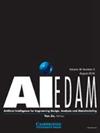一种基于脑电图的方法来解码创作过程中的认知因素
IF 2.3
3区 工程技术
Q3 COMPUTER SCIENCE, ARTIFICIAL INTELLIGENCE
Ai Edam-Artificial Intelligence for Engineering Design Analysis and Manufacturing
Pub Date : 2023-03-27
DOI:10.1017/S0890060423000057
引用次数: 0
摘要
摘要神经技术已被应用于深入了解与创造力相关的认知因素。先前的研究已经定性地确定了认知因素和创造力之间的关系;而数量关系,如认知因素和创造力的相对重要性,尚未完全确定。因此,以创意设计过程为例,本研究使用脑电图(EEG),旨在客观地识别与创意相关的检索、回忆、联想和组合等认知因素对创意的贡献。开发了一种基于EEG的解码方法的理论基础,该方法可以客观地识别创作过程中发生的认知因素。招募了30名参与者进行一项实践研究,以验证解码方法的可靠性。基于该方法,检测了认知因素的相对重要性水平与创造性产出质量水平之间的关系。结果表明,通过解码方法,召回和关联的发生具有较高的可靠性。研究结果还表明,联想是创造产出质量水平较高的主要认知因素。回忆是创造性产出质量水平较低的主要认知因素。本文章由计算机程序翻译,如有差异,请以英文原文为准。
An EEG-based method to decode cognitive factors in creative processes
Abstract Neurotechnology has been applied to gain insights on creativity-related cognitive factors. Prior research has identified relations between cognitive factors and creativity qualitatively; while quantitative relations, such as the relative importance of cognitive factors and creativity, have not been fully determined. Therefore, taking the creative design process as an example, this study using electroencephalography (EEG) aims to objectively identify how creativity-related cognitive factors of retrieval, recall, association, and combination contribute to creativity. The theoretical basis for an EEG-based decoding method to objectively identify which cognitive factors occur in a creative process is developed. Thirty participants were recruited for a practical study to verify the reliability of the decoding method. Based on the methodology, relationships between the relative importance level of the cognitive factor and creative output quality levels were detected. Results indicated that the occurrence of recall and association are reported with a high reliability level by the decoding method. The results also indicated that association is the dominant cognitive factor for higher creative output quality levels. Recall is the dominant cognitive factor for lower creative output quality levels.
求助全文
通过发布文献求助,成功后即可免费获取论文全文。
去求助
来源期刊
CiteScore
4.40
自引率
14.30%
发文量
27
审稿时长
>12 weeks
期刊介绍:
The journal publishes original articles about significant AI theory and applications based on the most up-to-date research in all branches and phases of engineering. Suitable topics include: analysis and evaluation; selection; configuration and design; manufacturing and assembly; and concurrent engineering. Specifically, the journal is interested in the use of AI in planning, design, analysis, simulation, qualitative reasoning, spatial reasoning and graphics, manufacturing, assembly, process planning, scheduling, numerical analysis, optimization, distributed systems, multi-agent applications, cooperation, cognitive modeling, learning and creativity. AI EDAM is also interested in original, major applications of state-of-the-art knowledge-based techniques to important engineering problems.

 求助内容:
求助内容: 应助结果提醒方式:
应助结果提醒方式:


